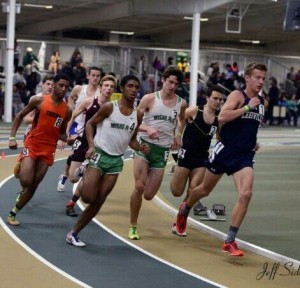The Power of Practice
“There is no glory in practice, but without practice, there is no glory.” Leesville athletic teams thrive on their
determination to improve. Practice is an essential aspect to any team’s success, but it does more for the team than improve their skills — it strengthens the bonds between teammates.
Men’s basketball – Ashley Tysiac
The Leesville Road men’s basketball team came into the season as one of the top teams in the area. The team was ranked fourth in the preseason HighSchoolOT.com Top 15 poll and is predicted to have a chance of making a run for the first place spot in the CAP-8 conference by season’s end.
With Alex Hunter, senior, Jonathan Mebane, senior, and Jalen Benjamin, sophomore, returning as three of the Pride’s leading scorers, the expectations for the team are high.
One of the aspects that makes Leesville an elite team is the way that they practice. Each day, the players follow an intense practice routine and participate in a variety of drills designed to prepare the team for games.
Every practice starts off with defensive drills focusing on skills such as positioning and rotations. Then, the team proceeds on to a technique drill such as shooting or cutting. Lastly, the team works on offensive plays, offensive skill drills, and free throws.
Alex Hunter, a Furman commit, said that he thinks the shooting drills the players participate in are important in developing good offensive skills. He also said that defensive drills are crucial in helping the team perform well in game situations.
Jonathan Mebane said that he thinks the shell drill, a defensive drill the team practices, helps the team prepare properly for games.
“Everybody has to talk, communicate, and work on their rotation for defense,” said Mebane.
He also said that the close-out drill, in which players work on getting a hand in the face of outside shooters, is important to use in game situations. “[Close-out drill] helps a lot because you’ve got to play defense and keep [opposing players] from shooting,” said Mebane.
Russ Frazier, head coach of the Pride men’s basketball team, said that practice is designed to match the speed and atmosphere of an actual game.
“I think trying to replicate the pace of a basketball game is more important than trying to prepare for it,” said Frazier. “We try to do things with pace and with speed.”
Frazier went on to say that he thinks that practice helps bring the players together as one unified team, which can be important in strengthening bonds and helping the Leesville men’s basketball team continue to be a great group.
“[The players’] efforts to bond and grow as a team are really important,” said Frazier. “I think that’s what practice does.”
With practices designed to be vigorous, fast and intense, the Leesville men’s basketball team is able to prepare to play their best in games and work towards perfection.
Pride Swimming – Grace Newton
While most students are still sleeping, the Leesville swim team is just getting ready to dive into a pool at 5:30 a.m. They then rush to shower and eat yet another breakfast, all while trying not to be late for school.
Before practice, Jack Rogers, coach and athletic director, writes a combination of sets on the whiteboard. These sets make up the practice — it includes a warm up, main set and warm down.
Most in-season practices consist of a mix between conditioning and aerobic exercises, however most end up emphasizing one or the other. Conditioning focuses on the swimmers’ base technique and building strength. Swimmers try to increase power and speed by swimming as hard as they can as fast as they can. Essentially, conditioning in the pool is equivalent to running “suicides” during PE or soccer/tennis practice — quick sprints back and forth, with little rest between reps.
Aerobic oriented practices are more long distance. Swimmers go long distances with a low heart rate to increase their endurance. This type of practice is a long, slow day — the equivalent of a cross country runner covering six miles at a slow pace to train muscles to use oxygen efficiently.
“Throughout the year the practices get harder, and we start to do more yardage. I definitely feel like it prepares me for the [season-ending] meets,” said Ainsley Duke, Leesville sophomore.
However, towards the end of the season, as the swimmers look to make regionals, they must adjust their practice routine in order to peak at CAP 8. The hard, mid-season practices set swimmers up for success.
In the weeks leading up to CAP 8, practices become slightly different for the Pride swim team. The max intensity workouts for the swimmers occur two weeks before CAP 8. Once CAP 8 is less than two weeks away, the yards each swimmer covers during a practice decreases, but the speed and intensity stay the same to ensure everyone is ready to compete at their very best at CAP 8. The harder, mid-season practices break down muscles but these muscles only repair themselves with this tapering.
This year the team is larger than the past, so practices were divided into “A” days and “B” days. Year-round swimmers have to sign up for two practices per month. They aren’t assigned to “A” or “B” days because most of them already swim twice a day, so they don’t have to go to as many practices.
“The expectation is for [students] to come to all practices they are assigned for,” said Rogers.
Swim meets can occur on any day of the school week and can end as late as 10:00 pm. On swim meet days, practices are cancelled due to the late ending time.
It is clear that intense practices are tough on the swimmers but will eventually begin to pay off as the season progresses. “The work put into practice show directly in the results at the meet,” said Abby Toubren, swim team captain. Practice is an essential part to the swim team success.
Men’s wrestling – Drew Walczyk
“Practice is definitely a place to learn and hone the skills. It makes you more knowledgeable, and gets you in a better place as far as competing goes,” said Jason Wyss, the head coach of the Leesville wrestling team. The team practices nearly every day of the week, sometimes multiple times a day.
According to Wyss, the team practices at least eight times a week and sometimes even upwards of ten. A common practice primarily consists of takedowns, defense, shots, live wrestling, and fitness. These drills are essential elements in a wrestling match and help prepare the pride for their toughest opponents.
“We are typically a lot more fit than other teams because we workout so much, and we are going to last a lot longer than other guys on the mats and then just wear them down until we beat them,” said Dan Mills, senior. Sometimes, endurance can overcome skill when it gets down to the wire during matches. In order to develop a never-quit attitude, the team has morning practices from 5:30 A.M. to 7 A.M. which, as Mills described, truly creates the tough attitudes and right mindset neccessary to win a wrestling match.
“If you got a guy that’s in really good shape, and maybe not technically sound early on you can win some matches on grit and conditioning, so as they learn and pick up the sport then their all the better for it. You need a total body; you think it’s a six-minute match, but you’re using every bit of your body in the match,” said coach Wyss, as he reiterated the importance of fitness and repetition.
During practices, Wyss tries to comprise workouts that keep the entire body in shape. When wrestling another player, every muscle in one’s body must be prepared to be used. Whether it be the arms, legs, back, or chest, every single part of the body must be in top notch shape.
Although skill and technique is a vital part to winning a match, it also takes grit. One has to have a desire to push through the pain experienced during a match.
The healthy and positive atmosphere in practice will also be a major factor to the team’s success. Wyss described how “[the team] works hard and they learn a lot.” Mills also emphasized that “once [they] hit the mats, [they] get after it.”
With a great work ethic, lots of dedication, and a healthy atmosphere, the team has created the ideal practice environment. They will continue to practice hard in order to have a successful season.
SPORTS
What makes a leader on the Leesville basketball team
By: Cayley Kennedy
Behind every good sports team is a collection of even better leaders. When it comes to sports teams, leadership is necessary in order to achieve success. Strong leadership is necessary in order to motivate us, guide us, and bring us together. A quality leader demands more than just being the best on the team. When it comes to basketball, being a strong leader requires much more than just skill.
Most people think of the leaders on the team as people who score the most points or are the most outgoing, however for Russ Frazier, coach for the Pride men’s basketball team, his captains are based solely on experience. Being a good leader requires knowledge of the game: Players need to be able to rely on their captains for direction and advice that they know is right.
Although experience is necessary to being a good leader on a team sport like basketball, communication is still key.
“You have to be able to talk, you have to get your point across and your teammates have to listen to you. [The captains have to be] respected, but also we have to respect each other,” said Frazier.
Good communication is what drives the team to flow, to execute passes and shots with little effort. Leaders must always be in constant communication with their teammates. They serve as the voice of the team; during games, captains must ensure that everyone is on the same page.
However, communication makes it possible for anyone to become a leader. “Leadership can come from anywhere. [The captains] may be having a bad day. Somebody else can pick up the other person by simply speaking. So communication is our big thing when it comes to leadership,” said Frazier. It is clear that without proper communication, the team’s success will be limited.
Lauren McNamara-Clement is a senior captain on the women’s basketball team at Leesville. After three years in the program, she has learned exactly what to do in order to be a good leader.
“I think leading both by example and through words is a big thing. If I say something, I hope they will follow me, but I also need to do things myself that I want them to follow.” On a team sport like basketball, words need to be backed up by actions in order for someone to be respected and viewed as a role model.
While leadership is important among the players on the team, it is also important to the coaches. “As a coach, there has to be a balance. You have to be able to correct, criticize, and compliment all at the same time. You have to keep pushing them in the right direction no matter what,” said Frazier.
Leadership on a basketball team comes from both the players and the coaches. Since coaches are just as involved in the development of the team as the players are, they must also exude strong leadership skills. They must demonstrate the characteristics that they want their captains to as well. Leading by example applies to both the coaches and the players.
Basketball is one of the several team- oriented sports at Leesville. It demands excellent communication skills out of its leaders in order to bring the team success. However, words mean nothing if actions don’t follow. Leaders must be a positive role model to the rest of the team, constantly motivating others to work harder. It is clear that when it comes to team sports, communication and action are the keys to triumph.
Leadership spurs success for wrestling
By: Jonathan Spear
“As iron sharpens iron, so one man sharpens another.”
In a sport of individuality, the Pride wrestling team values leadership to forge success and bring the team closer together. Though the match is settled on the mat, the impact of sideline leadership is the ultimate tool for victory.
During a wrestling match, a wrestler is completely alone, with only his opponent before him. However, encouragement and coaching from teammates can be the difference between a win and a loss for a wrestler.
The importance of leadership is unmatched in wrestling, and Ethan List, senior, believes that leading others toward improvement is essential to building success in practice or during matches. “In practice, you need to help people improve in different moves and we all help each other get better at specific shots or takedowns and all the little moves,” said List.
During matches, teammates coach and encourage one another.
In a sport where determination and grit can overcome skill, leaders turn to the power of encouragement and inspiration to drive a fellow wrestler to victory. “Sometimes you get stuck in a situation where you run out of time, and you have to encourage your teammates to fight through the pain and fight through being tired,” said List.
This season, the team has chosen three captains: Dan Mills, senior, Simeon Ruff, junior, and Zach Hedgepeth, junior. Although these three wrestlers are the only ones with the title as captain, Ruff believes every member of the team should be invested in leading one another. “Even though there are three captains, it’s an individual sport, so we all need to work together and help each other out.”
The team aims to take the initiative to stay together and work as one unit.
It may not always be easy to have strong chemistry, but through well-founded leadership, it is achieved.
“Making sure the team stays together and not separated…we still need to work together and ensure that we are all working toward the same goal instead of putting each other down,” added Ruff. The team must refrain from becoming too focused on individual achievements.
As a new wrestling season commences, the Pride Wrestling team yearns for a successful season. The team is returning two state qualifiers, and multiple conference champions. As the season wears on, the one thing that will not wear, is leadership.
An individual sports turns to leadership
By: Tyler Stocum
Many times leadership in sports is considered important only on team sports, rather than individual sports. Track is an individual sport; you don’t have anyone but yourself to help you run a race. However, there is still a team aspect.
The indoor track team selected six members of the team, three girls and three boys, as their team captains. The captains selected were Nick Barefoot, Nevada Moreno, Nathan Gamble, Katlyn Stallings, Bobby Haggerty, Delonte Matthews, and Jackie Oliphant.
“On the track team leadership and being a captain is being someone others can look up to, and for the new members on the team who don’t know the general routines being someone that they can look to for help and ask questions,” said Nick Barefoot, the distance captain for indoor track.
Captains on athletic teams are expected to uphold high expectations. They need to be highly skilled, have a strong voice and lead by example. Nevada Moreno is one of those leaders on the track team. She leads silently, letting her actions do the talking.
The team bonds together at meets, which is a way for them to gain team chemistry, something that the captains stress. “For indoor we have to travel to our meets since there is no indoor track around this area, so I think it’s fun being able to have a team vibe on the bus going into meets. Also, everyone lays around the track during the meet when they aren’t running, and the guys have a team flag that they bring to fly around during meets. The meets are just fun and chilled out when you’re not racing which makes it fun,” said Moreno.
Small rituals of the team create a fun and community atmosphere for all the runners to enjoy during meets.
Just as any other sport, in track you want to cheer your teammates on and that is a large part of the leadership aspect. “Having everyone cheer for their teammates during their races is where the team comes in. Many people feel track is an individual sport, and in some respects it is, but you win by having a full and deep team, having support for everyone single person while they are racing is the best way to show we are all a team, not just individuals,” said Barefoot.
Leadership is a large aspect to any sport and can make or break a team’s success in the end. It is clear that the key to being a good leader on a less team-oriented sport like track is constant encouragement and leading by example.
